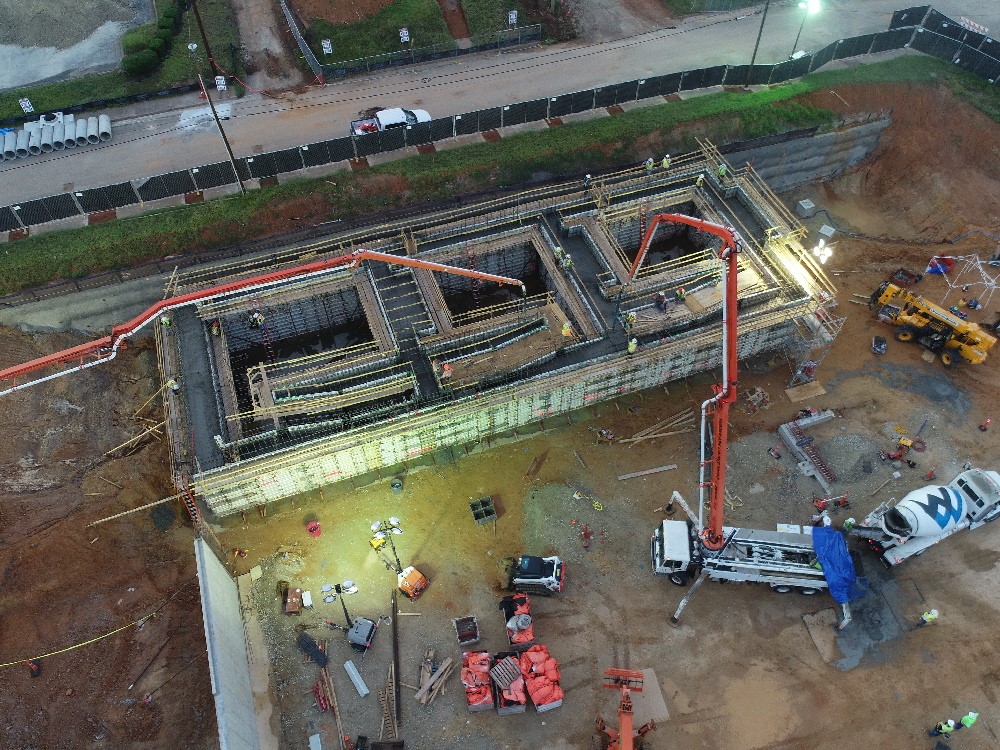Tackling linear accelerator vaults
In November 2021, McCarthy Building Companies, Inc. completed construction of the Northeast Texas Cancer and Research Institute — a collaboration between CHRISTUS Health and Texas Oncology. A Cottonwood Development project, the 85,000-square-foot research facility is located on the CHRISTUS Trinity Mother Frances — Tyler campus in Tyler, Texas.
The special nature of the project brought some unique challenges, including completion of three cast-in-place linear accelerator vaults. The project team self-performed two mass concrete placements totaling over 2,200 cubic yards of concrete for the vaults, which feature 12-foot-tall walls up to 8 feet thick and a roof up to 9 feet thick. The structures were placed monolithically to contain the radiation emitted from the accelerators, with each continuous pour lasting over 12 hours.
Tasked with a construction timeline during the Texas summer heat, an engineer was engaged to develop a temperature control plan in compliance with ACI 207 Mass Concrete standards. The concrete had to be cooled below 75 F at the point of placement to meet ACI guidelines. Facing summer temperatures above 100 F, the team replaced all the available water in the concrete mix with ice and injected liquid nitrogen to reduce the temperature.
Numerous temperature checks were completed, including immediately following the batching process, after probe injections and upon reaching the jobsite. Bluetooth wireless concrete temperature sensors were strategically placed inside the structure, so internal and external temperatures could be monitored remotely throughout the curing process.
After pouring, the concrete formwork was tightly covered with thermal blankets to maintain temperature. Another important post-pour consideration was timelines for stripping and curing the formwork. The temperature control plan may require a special stripping process that cannot be completed for days or weeks following the pour, which can delay subsequent work if not accounted for during planning.
In addition to tackling temperature control and forming operations, the team walked away with these key strategies for success with linear accelerator vaults.
Preconstruction
The vaults require a high degree of precision, which calls for a high degree of planning. Complete an independent takeoff to determine the necessary materials and manpower, then create the project schedule. This will provide a clear path for subcontractors to follow and help prevent unnecessary costs.
The time of year is also critical when considering the budget for placement. Methods for cooling concrete vs. maintaining heat can have drastic cost differences. Regardless of timing, testing is essential. Plan for multiple mass concrete mock-ups and engage all parties to test every step of placement.
Medical equipment coordination
Engage the medical equipment vendor prior to placement to verify all requirements will be met. You never know when equipment models and features have changed. The equipment vendor and physicist may also have location or routing specifications that affect forming and reinforcement.
Consider waterproofing requirements. If an under-slab waterproofing membrane is required, individual sleeves may be a better solution than large block-outs. You will also need to understand the limitations for the equipment isocenters. The tolerances for the isocenters may be stricter than the tolerances on the formwork.
Ready-mix suppliers
Partner with the supplier’s quality department to begin the mix design as soon as possible. The mix must be tested and finalized to meet all criteria before you can develop the temperature control plan. Consider all variables for the batching process, then test them under the most adverse conditions.
Examples include verifying the mix maintains slump and strength requirements during high temperatures, and confirming trucks can successfully travel from the plant to the site during peak traffic. There’s no stopping once the pour starts, so establish a backup for every aspect — equipment, operators, mechanics, QC personnel, parts, raw materials, drivers and trucks.
Site logistics
Strategically located pump trucks and concrete washouts will help pours run more efficiently. Large pours may require the washouts to be replaced during the process, so schedule this ahead. Ensure safe, accessible concrete truck paths to and from the washout locations and pump trucks. With hundreds of trucks accessing these areas, roads can quickly degrade if not properly constructed. Designate plenty of spotters to safely direct traffic.
Verify the size and quantity of pump trucks required, and request a backup truck and mechanic onsite. Since the concrete mix will likely be high-density, confirm the pump trucks can handle the stress of the operation.
Safety
Teams should prioritize weekly stand-down meetings covering relevant safety topics and conduct a daily task hazard analysis discussion. A major safety consideration for vault construction is providing entry and exit points to the top of the formwork, making sure rebar does not block access. Install 6-inch by 6-inch wield wire fabric on the top reinforcement layer of the mat slab and roof to create a safe walking surface for placement crews.
Due to the length and continuous operation of the pours, crews will likely need to be rotated to avoid exhaustion and overheating. If a pour will last longer than a normal shift, schedule the next shift accordingly so placement is not interrupted. Hydration and meal breaks should be coordinated in advance to maintain the rotation of manpower.
While linear accelerator vaults may not be something you see on every project, many of these strategies can be applied to other mass concrete pours. The more we learn from our experiences and each other, the greater impact we can make.





